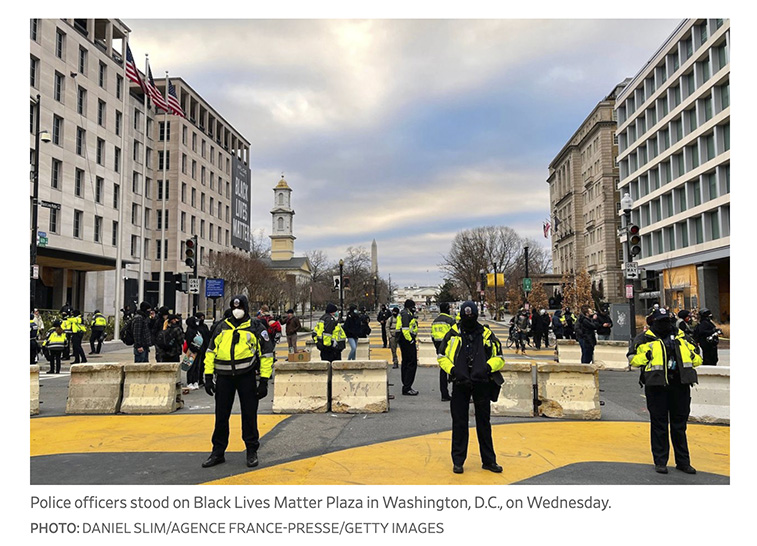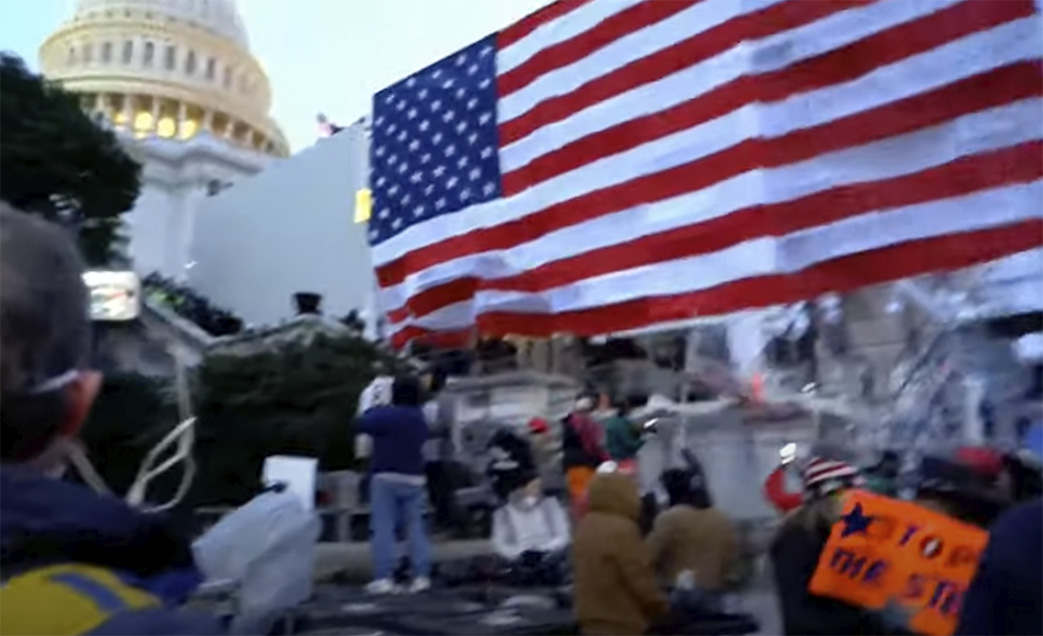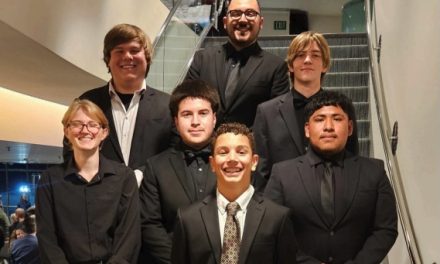Congress completes count of electoral college votes following protesters’ clash with police
This article was updated on Jan. 11 to reflect the cause of death of Capitol Police officer Brian Sicknick is under investigation.
WASHINGTON D.C. — As the unprecedented circumstances of 2020 spill over into the first week of 2021, the election results take center stage in the final count of the presidential election results. Subsequent the closing of polls on November 3, 2020, contrasting information persisted surrounding claims of election fraud, irregularities, and constitutional violations culminated in a rally on Jan. 6 in Washington D.C. as supporters of President Donald J. Trump protested the certification of state electoral votes.
The uncertainty surrounding the very term “president-elect” was cleared from the room late into the morning of Jan. 7 after a violent and deadly day at America’s capitol. Congress, in the joint session held to count the electoral votes from the several states, certified the 2020 presidential election for Joseph R. Biden and vice president Kamala D. Harris.
The grounds upon which the inauguration of Biden and Harris will be held in Washington D.C. were overtaken on Jan. 6 in a day of chaos by protesters and rioters that punctuated an end of the Trump presidency.
The day started with challenges against certification of the election results, from both public supporters and members of congress.
The “Stop the Steal” rally began at 10 a.m. ET at the U.S. Capitol, with President Trump among the speakers calling for political action by congress to object to electoral college votes cast for candidate Joe Biden from states where objections have been made. Representatives from seven states — Pennsylvania, Michigan, Nevada, New Mexico, Georgia, Arizona, and Wisconsin — cast “alternative” electoral college vote in conflict with the popular state vote counts.
Watch LIVE: Save America March at The Ellipse featuring President @realDonaldTrump https://t.co/lzjBiLoFwU
— RSBN 🇺🇸 (@RSBNetwork) January 6, 2021
The scheduled Joint Session of Congress convened to count the votes, with Vice President Mike Pence presiding over the count.
“After ascertainment has been had, that the certificates are authentic and correct in form, the tellers will count and make a list of the votes cast by the electors of the several states,” Pence announced as session began.
Pence announced that Alabama was the first state to present electors, but was asked by Virginia Congressman Morgan Griffith (R) how a member of congress may “make a parliamentary inquiry” concerning the reading of the electoral votes. Pence referred to Title III of the U.S. Code to say that such an inquiry would be considered “debate” and that Title III does not permit debate in the joint session.
As the crowd of protestors outside the capitol building began to assemble after marching from the Stop the Steal rally, the process of counting electoral votes began inside, in alphabetical order beginning with Alabama — casting nine votes each for President Trump and VP Pence.
Video evidence showed many different angles and many different storylines. The video below shows a police line and barricade delaying entry to some protestors, meanwhile later in the video pan it shows hundreds of people with access to the space.
they didn’t “breach” or “storm” the capitol building THEY WERE LET IN pic.twitter.com/SVeo6BcFV0
— ari⁷ (@moonddng) January 6, 2021
The Capitol Police was unprepared, and overwhelmed to handle the crowd. Following the event, the Capitol Police Chief Steven Sund announced his resignation.
Counting the Electoral College
As chaos churned outside, proceedings continued inside. Pence called for any objections to the count from Alabama. Hearing none, he moved onto Alaska, then Arizona. Arizona votes were cast for former Vice President Joseph R. Biden and Senator Kamala D. Harris. Answering the call for any objections to the Arizona slate of electors, Arizona congressman Paul Gosar (R) stood to object.
“I rise for myself and 60 of my colleagues to object to the counting of the electoral ballots from Arizona,” Gosar said.
Pence questioned Gosar for verification if the objection was made in writing with a signature of a U.S. Senator, which Gosar answered in the affirmative. A collective groan from one part of the attending congress was met with applause from another part, as the anticipated objection was made formal on the floor of congress in the joint session. Many stood in support of the objection,
“An objection made in writing and signed by both a representative and a senator complies with the law,” Pence confirmed. “The clerk will report the objection.”
The objection letter was read into the record, and Pence called for both houses of congress to withdraw from joint session to deliberate separately to bring back a response to the joint session.
As the individual houses convened to discuss the objection, the crowd thickened outside of the capitol building and skirmishes broke out between protestors and Washington D.C. police.
In the Senate chamber, discussion began with Louisiana representative Steve Scalise, who addressed
“I rise today to object to a number of states that did not follow the constitutional requirements for selecting electors,” Scalise said. “This is something that is clear that our founding fathers debated as a fundamental decision of how we choose our president.
“Each state as a process for selecting their electors and sending them to Washington” Scalise said, “and in a number of those states that constitutional process was not followed. That is why we are here to object.”
Scalise argued that there is no law that provides the executive branch of a state government the ability to select electors.
“It exclusively gives that ability to the legislatures,” Scalise said.
Scalise argued that Article II of the constitution had been ignored, and must be restored.
“We have seen more and more where the Democratic Party has gone into states and selectively gone around this process,” Scalise said. “That has to end, Madame Speaker. We have to follow the constitutional process.”
Scalise retired from the podium after his delivery, and was followed by California representative Zoe Lofgren who spoke to strike the objection.
“This day marks a crossroads for American democracy,” Lofgren said. “Those who object to the counting of the electoral college votes, which reflect the votes of the American people, want to substitute their preferences for the voters’ choice. That is not what our constitution requires and is at odds with the American democratic republic.”
In closing, Lofgren called for closure to the objection.
“The people spoke, it was not a close election,” Lofgren said. “I understand the disappointment people feel when their candidate loses … wait for the next election in four years if dissatisfied with the results.”
Ohio congressman Jim Jordan followed Lofgren with emphatic support for the objection.
“Americans instinctively know there was something wrong with this election,” Jordan said. “During the campaign, Biden would hold an event and get 50 people at the event. President Trump at just one rally would get 50,000 people. President Trump increased his vote by Latino Americans, increased his vote by African Americans, won 19 of 20 bellwether counties, won Ohio by eight, Iowa by eight, and Florida by three. He got 11 million more votes than in 2016, and house Republicans won 27 of 27 tossup races. But somehow, the guy who never left his house wins the election?”
Jordan noted requests for investigations that were declined. He accused the Democratic Party of pursuing the removal of Donald Trump from office by means of investigations by FBI Director James Comey, special counsel Robert Mueller, the “Russia hoax,” and impeachment trials into Donald Trump. He concluded that upon failing in those attempts, the Democratic Party then made unconstitutional decisions to change election rules to pursue the action to remove Trump from office.
“Only state legislatures set election law,” Jordan said, citing actions in Arizona, Pennsylvania, Georgia, Wisconsin, Michigan, and Nevada regarding voter registration, mail-in ballots, signature verification.
“It was a pattern, it was [the Democratic Party] template,” Jordan said, criticizing his Republican colleagues who dismissed the permanent damage caused by unconstitutional election changes.
Alternating representatives between those objecting and those calling to strike the objections made cases until recess was called due to a breach of the capitol building by protestors. Members of congress were escorted offsite to continue working through the objection process in a safe location as uncertainty descended on the capitol.
VIDEO: Protesters Storm Capitol steps. #CapitolBuilding #SaveAmericaRally @newsmax pic.twitter.com/7koxHgDUn9
— Mike Carter (@MikeCarterTV) January 6, 2021
The Capitol Besieged
Thousands of people gathered on the steps of the capitol building, with many entering the building in clashes with police and damaging property and committing theft.
Electoral college ballots rescued from the Senate floor. If our capable floor staff hadn’t grabbed them, they would have been burned by the mob. pic.twitter.com/2JCauUIlvg
— Senator Jeff Merkley (@SenJeffMerkley) January 6, 2021
Oregon senator Jeff Merkley claimed the “mob” would have burned the electoral college ballots, however there were no reports of any fires.
There were some documented instances of theft, with a letter stolen from Nancy Pelosi’s office, and a lectern removed by a man identified as Adam Johnson from Florida. The capitol police have posted calls for wanted persons.
The protest was mostly peaceful, although damage was caused and police were overwhelmed by the crowd. Inside, capitol police shot a woman as a crowd attempted to break through a barricaded door. She was later pronounced dead after being taken to a hospital for critical care. Capitol police worked to push the crowds out of the capitol building, with ongoing conflicts that included pepper spray, tear gas, and nonlethal munitions to disperse the crowd. Many left the capitol without incident. A U.S. Capitol Police Officer Brian D. Sicknick passed away, and after hospitalization was pronounced dead late Thursday.
According to ABC, reports of an attack by fire extinguisher is reported to be unsupported and an investigation into the cause of death is underway.
Several elected officials called for respect due to the capitol police and for peace, and nonviolent protest. Opposition of Trump called for actions against the President and others. Trump’s social media accounts on Facebook, Instagram and Twitter were all suspended yesterday, with some posts and videos removed.
I believe the Republican members of Congress who have incited this domestic terror attack through their attempts to overturn the election must face consequences. They have broken their sacred Oath of Office.
— Congresswoman Cori Bush (@RepCori) January 6, 2021
I will be introducing a resolution calling for their expulsion. pic.twitter.com/JMTlQ4IfnR
With the large crowd, there were conflicting reports about individuals who involved themselves in the crowd that did not appear to be in the same spirit of protest as most people, with some reported as bent on destruction — being reported as “provocateurs.”
With massive crowds on the steps of the building, many stood crowded — shoulder to shoulder — but nonviolent and simply waving flags. Some members of the crowd, dressed in black with faces covered, had tools for breaking windows and were being confronted by others who demanded they stop damaging the building. With one report of 100,000 people on the veranda, the videos from inside the building show estimates of a couple hundred people breached inside while most were demonstrating on the outside with calls to avoid violence and damage.
This video is better. You can hear people telling Antifa to stop. pic.twitter.com/wPtIjWIwhq
— Barney (@ligia4508) January 7, 2021
Claims of a large presence of Antifa members was dismissed by many who follow the movement closely. Andy Gno is one of the foremost experts regarding coverage of Antifa and confirmed that much to the Washington Examiner.
A Utah-based Black Lives Matter activist, John Sullivan, attended the event and entered the capitol building with the other protesters. He is reported to have said, “For me, it’s important from the group and the people around me to see that side of things, to see the truth. I don’t care, like what side you’re on, you should just see it raw.”
He reported that what he saw was not a mob bent on destruction, and most of the video evidence from the day shows people peaceably assembled on the capitol building steps.
“Protesters weren’t really, like, trying to burn anything down, they weren’t really trying to break anything, their main motive was to make it into the chambers,” Sullivan said.
A line of people exit the Capitol building. One bloodied in the head and more came out who previously stormed the building. pic.twitter.com/0MF2aAp3Ly
— Matthew Miller (@mattmiller757) January 6, 2021
Reporting by Right Side Broadcasting Nework provided live video within the active crowd, providing gathered Americans to voice their state of mind and feelings, which included anger and frustration over what they considered a “stolen election.” Brian Glenn broadcasts the damage from a small number of violent attackers and experiences tear gas first-hand on the steps of the capitol building.
LIVE Coverage with @brianglenntv from DC at the U.S. Capitol https://t.co/0DDSqQRQYz
— RSBN 🇺🇸 (@RSBNetwork) January 6, 2021
Just after 5 p.m. ET, the police performed crowd control against a protesting group that occupied the space where the inauguration will take place on Jan. 20. Some claimed Washington D.C. police were not only compliant with the efforts of the invading rioters, but were called “complicit” by Tennessee congressman Jim Cooper (D).
“Some people are worried today that some police were complicit with the protesters,” Cooper said. “It’s one thing to be friendly and to de-escalate the violence. But it’s one thing to take selfies with them (rioters) and let them go through the lines.”
Video of the Capitol Police allowing breaches in the gates, showed that hundreds of people were already inside the gated area. Some video showed police taking selfies with people dressed in red hats, and others showed video of a police officer leading a crowd up the stairs of the building while acting as if he was defending the building — questions persisted as to why the capitol police were unprepared for an event that was broadcast for weeks.
— MpD (@IndigoLeo10) January 6, 2021
Following a day of violence against the capitol building, disruption of congressional sessions, injury and loss of life, there were calls made for the arrest for those who perpetrated the crimes, including calls against President Trump. Additionally, questions regarding the security forces in Washington D.C. swirl, with suspicion about the preparedness or lack thereof. Images by Getty photographers show there were more officers standing at a fairly empty “Black Lives Matter” plaza than access points to the capitol building.

As the tear gas and crowds cleared from the capitol building, the tension subsided without burning of buildings or damage to businesses in Washington D.C. The protesters dispersed with police presence and a curfew of 6 p.m. announced in the capitol led to more arrests. According to reports, there were four people dead and more than 50 arrested over the day.
President-elect Biden referred to the day as “one of the darkest days in our nation’s history.”
“Don’t dare call them protesters,” Biden said in remarks from Wilmington, Del. “They were a riotous mob. Insurrectionists. Domestic terrorists. It’s that basic. It’s that simple.”
The chaos of the day ended in the early morning of the next, with the resolution to the 2020 election that was rife with disruption, followed by legal and legislative challenges, and ultimately punctuated by loss of life and physical damage to the nation’s capitol.
The joint session of Congress resumed and certified the electoral college vote at 3:40 a.m. on Thursday morning, closing a chapter of conflict that held a nation hostage for several months of election confusion that aligned hundreds of congresspersons on different sides of the arguments.















